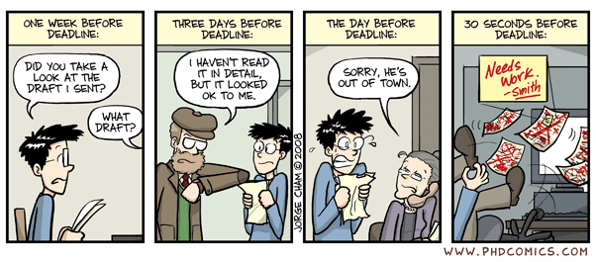
“Piled Higher and Deeper” by Jorge Cham, www.phdcomics.com
Tip 3: The Literature Review
The literature review starts early in the research phase and permeates through it – even beyond the literature review chapter phase. It is a critical part of the shaping of the research topic. By reading prior work, prior thesis you can isolate potential gaps and researchable topics! Assuming that you have a research-able topic -its literature review can be described as identifying, evaluating and critically assessing what has been published on your chosen topic.
In the current era of heavy digitalization and internet databases,the literature review entails scanning databases like Proquest, Ebsco, Emerald, Google Scholar…One typically searches for relevant literature using different keywords. It is highly relevant to keep track of the keywords used in each database and the results (#s of hits) that came out of it. One will also find that many times the same paper can be available on different databases. You may get hundreds of hits – but you may want to restrict the period, and type of literature that you wish to include in your review. PhD work will require you to focus on prior peer-approved papers – ideally published in quality international journals.
There are a few important tips that one can share here:
- Please DO keep a record of the keywords used, Databases scanned and hits received
- More important, as you do a literature scan and identify potent, relevant prior literature – keep a record of the same. Now – prior generations used to keep it manually on paper, and then we had a generation who I believe kept the record using excel files. NOW – (and this is a VERY IMPORTANT tip) – you can automate your record keeping process using reference managers like EndNote and Mendeley. The reference managers will permit you to create a database of the selected literature by pulling it from the internet database – WITH ALL RELEVANT FIELDS POPULATED in your EndNote library automatically. You can also save a copy of the papers where full text access is permitted and attach it to your EndNote library. The selected papers can be further grouped into different categories – and then pulled into different sections of your chapter as you write it.
- A Reference manager is CRITICAL to maintain a record and AN AUDIT TRAIL of your work. You can be asked by your Guide about the same (also by the academic council at your viva stage)- and this is a wonderful, convenient way to organize your work and meet the requirements. AND it will save you a phenomenal time versus other earlier generation manual methods.
- Also – please do save your work and keep copies of the database. I had a system crash and then a change of laptop (company policy) – I was saved because of my backup and because I used a licensed, paid copy of EndNote – Thomson Reuters support was good and retrieved/ transferred the EndNote files into the new laptop!
- You will find that EndNote eases the error-free citations. It recognizes hundreds of citation standards – and you can select it as per your target journal requirements. In my case, I chose APA format – and EndNote inserts the citations as per the standards into my chapter as I write it (using EndNote plug in Word).
- Another key advantage of a reference manager like EndNote is that you can generate your bibilography , with a click of button at the end phase of your research! The entire bibilography chapter is generated fully formatted in the selected citation format!
- Mendeley is free – I have not used it and I am not sure if it gives same level of support – but I have heard good word-of-mouth about it. You can explore it and then take a call. I , for one, remain an EndNote user.
- While writing a literature review – do not just copy an abstract from the review. You will be surprised how easy it is for a Plagiarism Check to isolate such shallow work. You need to capture the essence of the work by appropriately para-phrasing it. And , if required, insert text from original work in quotations to pass the plagiarism check. Do note that most PhD programs have defined an academic rigor in their plagiarism criteria and you should acquaint yourself with it and align your effort with it.
- Finally, you have to rise beyond paraphrasing the para work. You have to do a critical review of the work – eventually, identifying gaps in the academic rigor, topical analysis, choice of analysis, modeling basis. It is only when you do this that you will rise to a logical identification of potential research gaps.
You can access more details on Endnote here:
EndNoteand Mendeley here:
Mendeley(you can google search “Mendeley vs EndNote ” -or any other reference manager , as you wish) .
and access the other tips at:
India-InspiresDo have fun on your journey:

